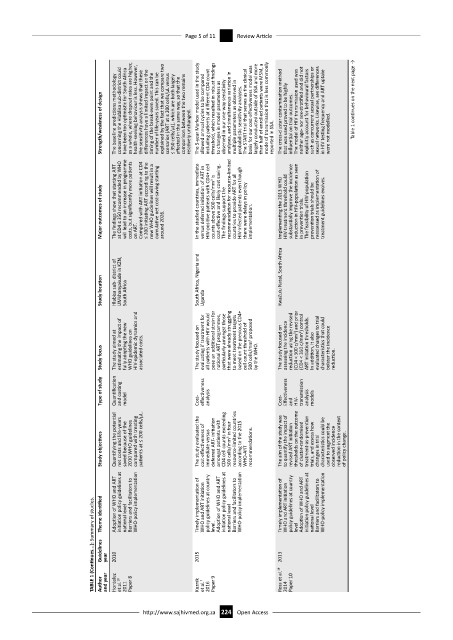Page 232 - HIVMED_v21_i1.indb
P. 232
Page 5 of 11 Review Article
Strength/weakness of design The baseline predictions methodology concerning the Hlablisa sub-district could have been too optimistic for South Africa as a whole, where dropout rates are higher, health-seeking behaviour is less. However, the sensitivity analysis shows that these differences have a limited impact on the timing of the break-even point and the number of life-years saved. This can be explained by the fact that we compare two scenarios (ART at ≤ 200
Major outcomes of study The findings show that starting ART at CD4 ≤ 350 recommended by WHO will lead to an increase in programme costs, but significantly more patients on ART. Compared with ART initiation at CD4 ≤ 200 initiating ART according to the new WHO guidelines will result in a cumulative net cost-saving starting around 2026. In the studied countries, immediate versus deferred initiation of ART in HIV-positive patients with CD4+ cell counts above 50
Study location Hlabisa sub- district of UMkhanyakude in KZN, South Africa South Africa, Nigeria and Uganda KwaZulu Natal, South Africa
Study focus The study aimed at estimating the impact of fully adopting the new WHO guidelines on HIV-epidemic dynamics and associated costs. The study focused on evaluating if treatment for all patients with HIV would pose an additional strain for national ART programmes, particularly amongst those that were already struggling to meet treatment targets based on the previous CD4+ cell count threshold of 500 cells/mm 3 proposed by the WHO. The study
Type of study Quantification and costing model Cost- effectiveness analysis Cost- Effectiveness and HIV- transmission analysis models
Study objectives Quantifying the potential net costs and life-years saved because of the 2010 WHO guidelines compared with treating patients at ≤ 200 cells/µL. The study evaluated the cost-effectiveness of immediate versus deferred ART- initiation amongst patients with CD4 cell counts exceeding 500 cells/mm 3 in four resource-limited countries according to the 2015 WHO-ART recommendations. The aim of the study was to quantify the impact of
TABLE 1 (Continues...): Summary of studies. Theme identified Guidelines year Adoption of WHO and ART 2010 initiation policy guidelines at national level Barriers and facilitators to WHO-policy implementation Timely implementation of 2015 WHO and ART initiation policy guidelines at country level. Adoption of WHO and ART initiation policy guidelines at national level Barriers and facilitators to WHO-policy implementation Timely implementation of 2013 WH
Hontelez
and year
Author
Paper 9
Paper 8
Kuznik
et al. 18
et al. 7
2016
2011
http://www.sajhivmed.org.za 224 Open Access Ross et al. 19 2014 Paper 10

